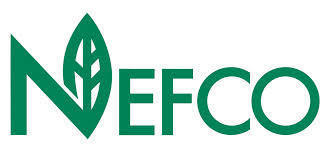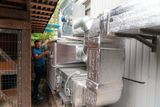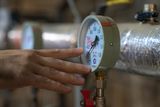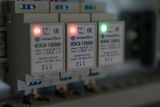Reconstruction of the heat supply system of the Segezha Hotel makes it possible to save energy
Hotel Segezha took part in the project KA5041 "Green technologies in the field of tourism to reduce the negative impact on the environment". After analysis of the situation in the hotel was conducted by experts on energy conservation, it was decided to reconstruct the building's heat supply system.
The main efforts were made to reconstruct the thermal unit of the hotel building. They included the dismantling of the old heating unit and the wiring of pipes from the unit to the building because it was large and inefficient. Then a new modern individual heating unit was installed. Since the room is large, it was possible to arrange it linearly, which allows to quickly and conveniently maintain it. A lot of monitoring equipment is installed at the thermal unit to identify possible malfunctions and pressure drops in the system. All pipelines are reliably insulated.
The heat source for the hotel is the Segezha Central Heating Plant. Previously, hot water from the heating plant was taken for heating the building and for the hot water supply system. Now the heat from the central heating plant is taken only for heating the building, and as for heating water for the hot water supply system, special heat exchangers are installed in the individual heating unit, that heat up cold water received from the city.
The fundamental difference is that the hot water supply is now regulated depending on the outside temperature, for this purpose special sensors are installed outside of the building, as well as on the needs and wishes of the hotel, which are set on a special remote control. The desired temperature is set on it and data on heat consumption is collected.
Previously, the hotel paid for the heat supplied by the plant, a lot of heat was lost in the heating unit itself, the hotel did not have the ability to regulate the temperature. Now the automation limits the heat supply at the entry point, depending on the temperature outside and the wishes of the hotel, and it pays only for the heat that it consumes.
In addition to saving heat and reducing costs, additional advantages were indirectly obtained related to increasing the convenience of maintaining the system, increasing its reliability, and increasing comfort for residents. For this purpose, pumps equalizing the pressure in the system, balancing valves, automatic valves were installed. All this makes it possible to maintain stable pressure in the system, the same pressure and temperature in all rooms.
Another energy-saving solution was the installation of a heat exchanger. The place where a lot of energy is used and often lost is small-scale food production: various kitchens, bakeries, etc. The hotel also has a small bakery. Previously, everything was arranged quite simply here: there was a supply ventilation to provide air to the bakery, in which an air heater was installed so that condensation would not form, and the air heated during baking was simply thrown out into the street through the exhaust ventilation. Such a system, in addition to low energy efficiency, caused problems: it could not be regulated, it was impossible to allow the temperature in it to fall below zero and as a result it simply failed. This prompted the hotel to introduce another energy-saving device - a heat exchanger.
At first, the old system was dismantled, simultaneously freeing up several rooms. Then we installed a compact heat exchanger with wiring for the bakery. In the recuperator, cold air from the street is heated by warm air from the ovens, passes through the filtration system and enters the room. Thus, the room heats itself, the heat is not thrown out into the street, and the hotel saves.
Thanks to the project KA5041 "Green technologies in the field of tourism to reduce the negative impact on the environment", the reconstruction of the hotel's heat supply system has been completed. The past winter has shown the effectiveness of its work. All parameters were normal and according to preliminary calculations of specialists, the savings amounted to about 30%.










